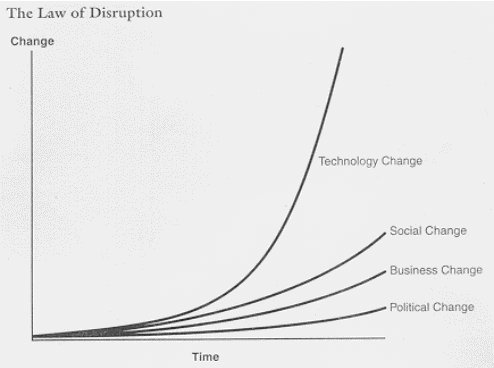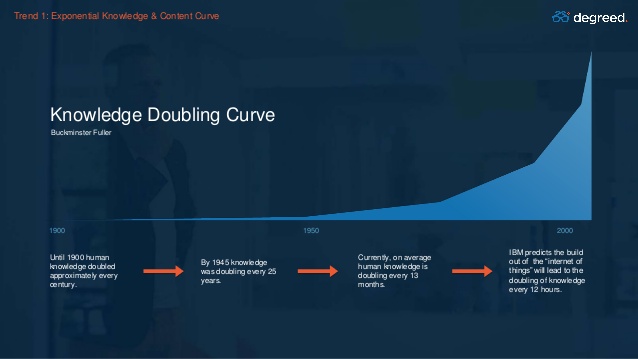![]()
Who doesn’t want to be more innovative? In gov-speak, the term innovation has achieved a glorified position, and is frequently deemed to be a strategic necessity.
For most of us working in government, it’s safe to say we got to where we are by virtue of our experience and expertise. For those of us who aspire to advance to positions of leadership, the belief is that we must achieve mastery within our technical specialty in order to stand out from the rest of the crowd on a job application.
This is typically accomplished through demonstrating repeated successes within our field. For most of our country’s history this system has worked well; the reasonable pace of change allowed one to work, live and support their family for their whole life; often without even leaving their hometown or state. Given that the pace of change is no longer incremental, but exponential, will these traits be applicable in the near future? Does a reliance upon this model allow government to innovate and keep pace with the private sector, social trends, and technological advances?

The Law of Disruption
In his book The Critical Path, Buckminster Fuller first suggests the theory of the knowledge doubling curve. Fuller describes this curve as starting in the year AD 1. At this time, all of human knowledge was represented in what he called a “knowledge unit.” By 1500, human knowledge had doubled to two knowledge units. The second doubling took place in 1750, to four units. This doubling was accelerated by the invention of the printing press and oceangoing sea vessels. By 1900, human knowledge doubled again to eight units. The next doubling, to sixteen units, took until just 1950, and the next, to thirty-two units, in 1970 and again to sixty-four units in the late 1980s. Today, it is estimated that human knowledge doubles roughly every twelve months, with some postulating that by 2020, the totality of human knowledge will double every twelve hours.

The Knowledge Doubling Curve
This explosive growth of knowledge has fundamentally altered the way we live and work. Historically, it was almost a foregone conclusion that an individual who started work in 1925 would be engaged in the same type of work when they retired. The reasonable pace of change allowed one to live one’s life in more or less the same way. This is no longer accepted – or perhaps possible – particularly for younger generations. The idea of achieving long-term career mastery lines up with self-determination theory and what author Daniel Pink refers to as “Drive.” In his book Drive: the Surprising Truth About What Motivates us, Pink breaks down shared human motivations into three distinct parts, which he calls:
Mastery (the need to be good at things)
Autonomy (basic need for freedom)
Purpose (intrinsic personal satisfaction/meaning)
Pink’s basic theory – backed up by significant boundary-spanning scientific consensus – is that human beings all desire the freedom (Autonomy) to get good at things (Mastery) that are meaningful to us (Purpose). If we accept as fact the assertion that we get to where we are by being good at our jobs, then it is only natural that people will resist the idea of being perceived as less-than-competent.
Throughout our school years and continuing into our working lives, we have been taught that good performance means avoiding failure and not making mistakes. In terms of creativity and innovation, this is a big problem, because failure is an unavoidable part of innovation and experimentation. Contrary to what Hollywood would have us believe, innovation is much less about revolution than it is about evolution. Far from the “lightning bolt from above” or “eureka!” moment, innovation is an iterative, trial and error process that demands modesty and the acceptance of mistakes and failure. We resist true innovation because we focus only upon what we are good at and what got us to where we are today. We must loosen our dependence on our desire for mastery and, as Erika Anderson coins the phrase in her book Be Bad First “get comfortable with being a novice again.” In short, we need to get comfortable with being uncomfortable.
Most importantly, we need to see trial and error as a necessary part of learning new skills and new ways of thinking. Abraham Maslow stated that an individual would engage in learning only “to the extent he is not crippled by fear and to the extent he feels safe enough to dare.” One of the reasons computer games are so popular is that they provide a safe space in which to “fail.” They also have a very shallow learning curve, allowing us to feel a sense of mastery very quickly; the difficulty scales proportionally to our ability and time invested, thus fostering a continual sense of challenge and mastery. Until we can accept that failure is a necessary part of learning and innovating, we have little hope of innovating ourselves into a better future.
We need new criteria in government job circles. We must look for and reward innovative thinkers and realize that performance is not a zero-sum game. We must look for ways to engage in continual learning on the job, recognizing that this is a key component of innovation and creativity. If you are a supervisor or a leader, try to incorporate opportunities for learning and innovation into the workflow. By intentionally fostering greater autonomy and purpose among your employees, you can relieve some of the pressure on the mastery drive. As an aspiring leader, look for ways to incorporate these opportunities both inside and outside the workplace and get comfortable with the idea of being a novice, even if you have a decade or more of technical experience. It is only through being open to such ideas, that we may encourage the innovative thinking so vitally needed in the public sector today.
Dylan Mroszczyk-McDonald is part of the GovLoop Featured Blogger program, where we feature blog posts by government voices from all across the country (and world!). To see more Featured Blogger posts, click here.




Dylan:
This is a good piece of writing. Well done!
Love,
Dad